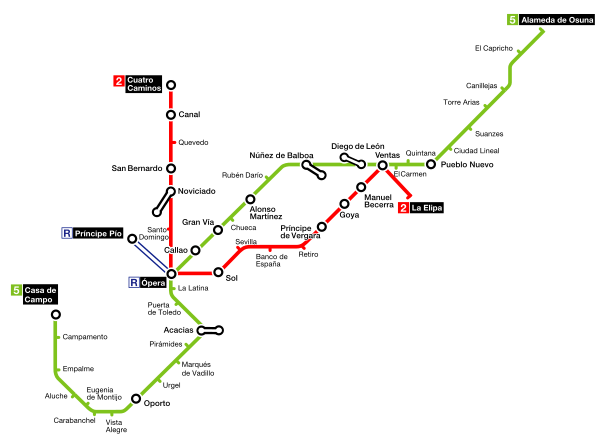Opera station
Ópera is a station on lines 2, 5 and Ramal of the Madrid Metro located under Plaza de Isabel II, in the Centro district of Madrid. The station allows access to an area with tourist landmarks such as Teatro Real, Plaza de Oriente and the Royal Palace. The name of this station comes from being located next to the Madrid opera house, the Teatro Real.
History
The station was opened to the public on December 27, 1925 for lines 2 and Ramal under the name "Isabel II", after the square where it was located. The platforms of lines 2 and Ramal are located at the same level, the first being 60 m and the second shorter at first, although they were later extended to 60 m in length and in width.
After the proclamation of the Second Republic on April 14, 1931, the new authorities approved by Decree of April 20 the suppression of all denominations that made reference to the Monarchy. For this reason, on June 24, the Isabel II station was renamed "Opera". That same year, the square also changed its name to Captain Fermín Galán, one of those responsible for the failed uprising that in 1930 tried to overthrow King Alfonso XIII. On June 5, 1937, the station would change its name again at the proposal of the City Council so that it coincided with that of the square. However, the establishment of the dictatorship of Francisco Franco after defeating the republican forces in the Civil War, meant a new change in the names of different streets, stations, etc. For this reason, in 1939 the square returned to being "of Isabel II", and the metro station recovered the name of "Opera" which it has carried ever since.
Before line 5 came into operation, the station had a different entrance to the current one, perpendicular to Arenal street instead of parallel.
On June 5, 1968, the platforms of line 5, located deeper and 90 m long, were opened to the public.
The station has been partially renovated, changing walls and vaults between 2003 and 2004.
On March 23, 2011, the station was reopened, which was undergoing works to improve accessibility. It currently has a new 821 m² lobby (previously it had 114), and 3 elevators were installed, one from the lobby to the street and two from the lobby to the different platforms, as well as several escalators. After this reform, the entrance to the station was moved from one side of the square to a new one in the center, with two stairs and an elevator.
Furthermore, the station integrated the archaeological remains of the old Fuente de los Caños del Peral, which were discovered during the works, through the creation of an underground museum.
Accesses
Plaza de Isabel II Lobby
- Arenal Pza. Isabel II, 9 (esquina C/ Arenal)
- Campomanes Pza. Isabel II, 5 (near C/ Campomanes and C/ Arrieta). For Royal Theatre
 Elevator Pza. Isabel II, 8
Elevator Pza. Isabel II, 8
Lines and connections
Subway
| ; | ► station | line | station oriented | header |
|---|---|---|---|---|
| The Roses | Sun | Santo Domingo | Four Ways | |
| Alameda de Osuna | Shut up. | Latin America | Casa de Campo | |
| end line | Prince Pio | |||
Buses
In August 2019, the lines to Plaza de Isabel II were diverted due to the works on Calle Bailén, establishing their head in the nearby Plaza de España. This itinerary modification became final on November 19, 2021, with the end of the works, after a road reorganization in the area. The modified lines are 25, 39 and interurban 500.
Curiosities
- The beginning of the film Premium Opera Fernando Trueba rolled in the subway mouth of this station.
- After one of the walls of the platform of line 2 you will find the Fountain of the Caños del Peral. Due to the works that occurred from 1809 with the creation of the Teatro Real and the subsequent ordination of the square of Isabel II, they buried this source, formed by a large granite pylon of the Cabrera with a number of between six and seven caños, separated from the stream of the Arenal by a prettile. The historic source was discovered during the refurbishment of the station in 1991 and a museum was created underground to visit the remains.
Image gallery
Contenido relacionado
Maurice Jarré
Aretha Franklin
Wassily Kandinsky




